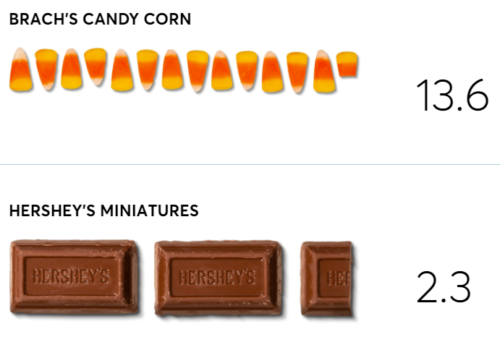I’m on the visionary panel. To register, click here.

Halloween is about one thing only: candy.
Candy has a place in diets, just not a big one—added sugars are best consumed at no more than 5% to 10% of calories (for many people, that’s 100 to 200 calories). It doesn’t take much candy to get to those numbers.
Consumer Reports has a helpful report on what 100 calories looks like: 13.6 candy corn kernels (see note at end) and 2.3 Hershey’s miniatures.

The candy industry doesn’t think you eat enough. Candy, it says, fuels the U.S. economy.
Making chocolate, candy, gum and mints, our industry plays an important role in the U.S. economy. We create good-paying jobs in the manufacturing sector in the U.S., and support thousands of additional American jobs as we sell our products in the marketplace, and source our ingredients, packaging and transportation. Additional jobs, known as induced jobs, are supported through the re-spending of wages throughout the supply chain.
Not only that, but candy is an essential part of health and wellness lifestyles (the candy industry’s at least):
The National Retail Federation predicts that this fall “consumer spending on Halloween-related items is expected to reach an all-time high of $10.14 billion, up from $8.05 billion in 2020.” Of this total, spending on candy is estimated to reach $3 billion, up from $2.14 billion.
Trick or Treat? Enjoy the Halloween weekend.
A note on candy corn
It would never occur to me that anyone would care, but how’s this for candy-industry research:
While there is some debate about the best way to enjoy this classic Halloween candy, most Americans say they enjoy the whole piece of candy corn at once (52%), while 31% of people start at the narrow white end and 17% of people start with the wider yellow end.